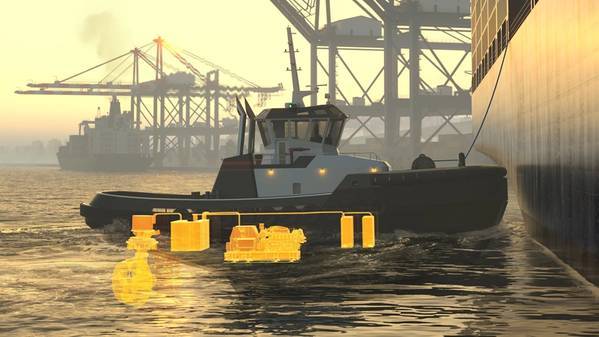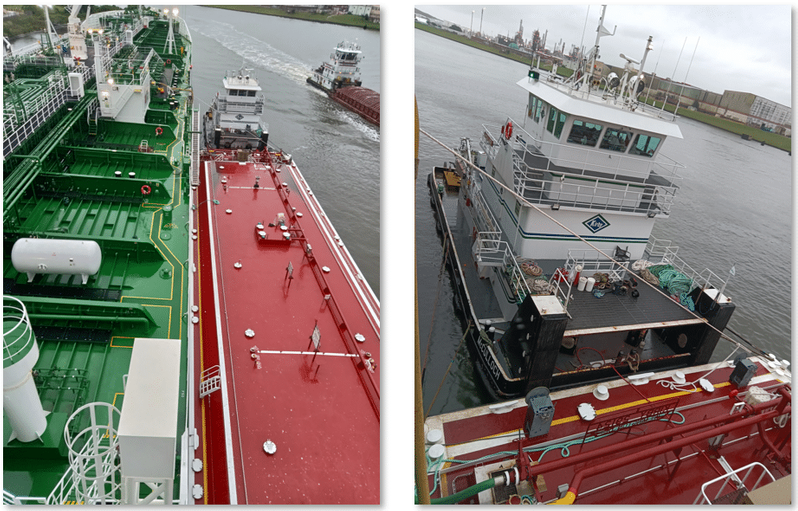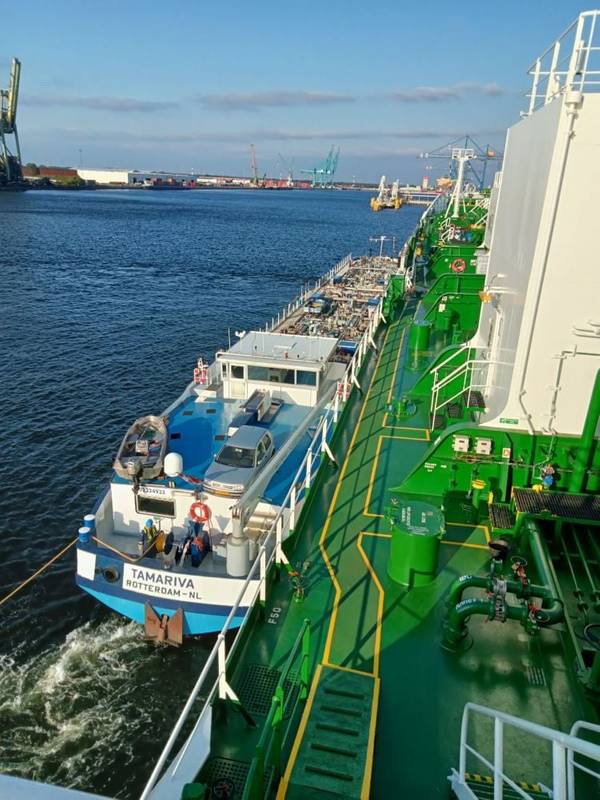Future Fuels: Methanol
Any commentator on the maritime business decarbonization voyage will offer something along the lines of "There will be multiple fuels…" With the International Maritime Organization (IMO) meetings of its Maritime Environmental Protection Committee (MEPC) set for early July, it is likely that targets for emissions will be tightened. Whatever mileposts that the IMO actually establishes, there will be no prescriptions handed down on how to get there. By mid-2023, nearly two years after the late 2021 alternative fuels crescendo in the aftermath of the COP26 meetings in Glasgow, numerous alternatives to the present dominance of fossil fuels are now being trialed and implemented.
While the word "winner" might be too strong, one fuel for maritime uses, methanol, does seem to be gaining serious traction. At an industry conference, held in late Winter 2023 in New York, John McDonald, Executive Vice President and Chief Operating Officer (COO) for American Bureau of Shipping, offered that: "Methanol is fast becoming the alternative fuel of choice for shipping in the energy transition, with an infrastructure that is now becoming established beyond grey methanol with agreements for green methanol generation and supply being developed all over the world." He noted dozens of methanol projects in the maritime sector are underway, and added, "Green methanol production is scaling up and starting to enter the supply chain in significant volumes. This, combined with its other inbuilt advantages of established technology and ease of handling, will rapidly give methanol critical mass in the market." In an ABS release regarding its approval in principle (AIP) of a low flashpoint fuel handling system, McDonald pointed to specifics of the fuel, saying, "Its ease of storage and handling, emission reduction and low-temperature operation characteristics make it a promising solution." ABS has developed a set of rules for methanol fueled ships.
Besides Maersk (working with ABS on a recent order of six methanol dual fueled 17,000 TEU vessels from Hyundai, and retrofitting up to 11 vessels with MAN B &W engines), containership operator CMA CGM has also made recent news with an order of 12 x 15,000 TEU ships from China State Shipbuilding Corporation (CSSC). On the bulk carrier front, Cargill has taken the lead in providing charter backing on orders dual fueled (diesel/ methanol) vessels.
In early June, the Korean Register (KR) granted an AIP for a medium range (MR) tanker design with the vessel fueled by methanol and marine diesel. According to KR (working on the project in conjunction with South Korean shipbuilders K Shipbuilding and equipment manufacturer S&SYS), "The vessel incorporates two methanol fuel tanks positioned on the port and starboard sides of the open deck." For its part, Alfa Laval announced that a number of projects are underway (with AIP from ABS in hand, but no vessel owners specified) that would see methanol fueled boilers on larger vessels.
Though mega box carriers, and now deepsea tankers, have garnered many headlines, naval architects, engine manufacturers and vessel owners are also looking closely at methanol's potential for smaller vessels, notably towing vessels and tugs serving fleeting and ship assist operations in ports. But methanol fueling is not without challenges, not the least of which is the ability to secure space for fuel tankage. For smaller vessels, hydrogen fuel cells- with H molecules supplied from methane, are receiving a great deal of attention.
One company that is pressing ahead is e1 Marine, a joint venture between vessel financiers Maritime Partners, LLC (MP), methanol to hydrogen technology innovators Element 1 Corp., and deepsea tanker owner Ardmore Shipping. e1 Marine has a proprietary methanol to hydrogen generator (also known as a reformer) technology designed to feed hydrogen into an onboard polymer electrolyte membrane (PEM) fuel cell. The M18 methanol to hydrogen generator, which takes a mixture of methanol and water, is packaged into a module which is similar in size to a commercial refrigerator. The generator's output feeds a fuel cell that produces electricity, fed to a DC grid that is in turn fed to electric motors that turn the propellers, to handle the vessel's hotel load or to a battery bank for storage and reuse.
European owners have utilized fuel cells, fed by methanol, from the Boston-based Advent Technologies. Advent's work included participation in Rivercells, a demonstration project funded by the German government. This project, where the yard Meyer Werft also participates, aims at developing and demonstrating a safe practical solution for a hybrid electric energy system for inland waterway ships using fuel cells in confined maritime applications. In cooperation with Innogy (an energy company, now part of the larger E.ON ),the passenger vessel Innogy was built for operation in German waters.
 Maritime Partners is developing the Hydrogen One towboat for operator ACBL (Image: Elliott Bay Design Group)
Maritime Partners is developing the Hydrogen One towboat for operator ACBL (Image: Elliott Bay Design Group)
In demonstration of this innovative technology to participants in the workboat marketplace, Maritime Partners is constructing the M/V Hydrogen One, with a design from Seattle-based Elliott Bay Design Group (EBDG), at Intracoastal Iron Works in Bourg, La. Maritime Partners' vice president of business development, Beau Berthelot, has said delivery is anticipated for 2024. The boat, employing e1 Marine's proprietary methanol to hydrogen generator technology, will be operated by American Commercial Barge Line (ACBL), which operates a fleet of nearly 190 towboats in regular services on the inland rivers and along the Gulf Coast. Maritime Partners describes Hydrogen One as "intended to mimic a 2,000 hp inland pushboat…that boat can go anywhere in the inland waterway system…with its expected range, it would be serving between New Orleans and Houston, as an example." The boat will fall under Subchapter M, and Maritime Partners explained that it will meet the U.S. Coast Guard requirements for handling methanol as a fuel. "Workboats do handle methanol, so there is existing precedent. A number of OSVs currently in operation are designed with methanol storage and transfer systems for routine delivery of methanol out to rigs in the Gulf of Mexico. We are working closely with the Coast Guard on making sure that the M/V Hydrogen One operates safely." Maritime Partners offers a comparison of the emissions profile of e-1 Marine's M18 reformer technology compared to conventional diesel, and said, "Based on e1 Marine's third party validated modeling, when the M/V Hydrogen One comes into operation, we feel that we can achieve a 99% reduction in regulated U.S. marine emissions, running on currently available, industrial grade (gray) methanol."
Naval architecture firm Glosten is also exploring methanol fueled tugs and workboats. This includes its recent SA-100 design: a 100-foot harbor assist tug developed jointly with ABB. Tugboat veteran Peter Soles, marine operations and business development at Glosten, explained, "What we've done here is introduce a new vessel concept. At Glosten, we strive to read what's going on in the workboat market, keep pace with emerging technologies and new regulation, then develop vessel ideas that we think will resonate with existing and potential new clients." He added, "We've had a number of conversations with vessel operators who are intrigued with the idea… some of whom are folks that have not called us before." Glosten describes the SA-100 methanol-hybrid tug as "propelled by two methanol-compatible CAT 3512E gensets powering L-drives. The gensets are complemented by a marine battery bank for zero-emission operation when transiting, and for 'boost' power to achieve its peak bollard pull of 90 short tons."
 Glosten has unveiled a methanol-fueled tug design, developed in partnership with ABB. (Image: Glosten)
Glosten has unveiled a methanol-fueled tug design, developed in partnership with ABB. (Image: Glosten)
Robert Allan Ltd., naval architects from Vancouver, B.C., have been working closely with a number of tugboat companies, most notably the Svitzer subsidiary within the Maersk group, on a number of concept designs, as well as communicating closely with a number of shipyards, including Uzmar (which recently delivered a diesel fueled ASD ship assist tug for Svitzer) in Turkey, on possible projects. Jim Hyslop, its director of project development, explained that his firm is evaluating a number of different configurations for tugs, including some with fuel cells and others with conventional engines adjusted to burn methanol. "We are always looking at new equipment," he told Marine News. Asked about trade-offs between fuel cells and internal combustion engines, he said, for ship assist and similar, that the fuel cells "may not be volumetrically efficient for the amount of power produced, and would likely require an external battery." Hyslop added, "Sometimes, it can be very challenging to fit everything needed into a tight space; smaller tugs may not have sufficient space. So, we are still exploring."
Class society Lloyds Register (LR, working closely with e-1 Marine), has also been extremely active in facilitating maritime decarbonization, with a big focus on methanol. It has also developed a set of rules for methanol fueling. Duncan Duffy, global head of technology, electrotechnical systems at Lloyd's Register's Global Technology Centre (in Southampton, U.K.), asked about the trade-offs of internal combustion versus fuel cells, explained that, "As well as the emissions improvement achieved by methanol systems, energy usage can be a factor in selecting the power system configuration. Reformed methanol fuel cells may achieve somewhat higher energy conversion efficiencies compared with methanol direct combustion engines, which are comparable to diesel engines at around 40%. This can contribute to the economic case if reassuringly expensive green methanol is the target fuel stock."
"Chicken and egg" issues surround all alternative fuels. Vessels can burn them, but they need to be widely available; methanol is no exception. LR has recently kicked off its "Fuel for Thought" series of webinars and reports, with an in-person session, in Singapore held in conjunction with ING Bank, discussing methanol. LR was able to bring in multiple stakeholders; the Singapore session was attended by owners, charterers, engine OEMS and The Methanol Institute. LR's Taylor Wamberg, business development manager, shipping markets at Lloyd's Register, based in Singapore, told Marine News, "We are also working with future fuel suppliers on the development of their fuel strategy." Worth noting is Maersk's efforts to source fuel; it has signed agreements for 1.4 to 2 million tonnes per year of methanol—including bio-methanol (from agricultural and forestry residue and municipal waste), e-methanol (solar, wind and renewable CO2) and green methanol (using biogenic CO2)—to fuel its new generation containerships, according to Intelatus Global Partners, which added Maersk is also reviewing many more fuel supply partnerships
Barging is an integral element of the fuel supply chain. Illustrating Berthelot's points about methanol handling, Kirby Corporation recently announced that it had carried out two barge-to-ship methanol bunkerings of deepsea vessels, in the Port of Houston. Two Stena product tankers, Stena Pro Marine and Stena Prosperous, were refueled with methanol via Kirby barge while they were discharging clean petroleum products. Stena (working in a joint venture with Proman, a provider of products derived from natural gas) has also done methanol bunkerings at the Port of Antwerp-Bruges.
 Kirby methanol fueling of Stena tanker at Port of Houston. (Credit: Proman Corporation)
Kirby methanol fueling of Stena tanker at Port of Houston. (Credit: Proman Corporation)
Methanol can be sourced now at major shipping hubs, and its availability will expand in the future. Wamberg, from LR, also told Marine News, "Tugs operate in a wide range of locations, where the availability of the fuel and flexibility of use can be key. A dual fuel internal combustion engine is a good choice as tug operators maintain that flexibility. If they cannot bunker methanol in the port they are working in, or move to another location during the asset's life, then they have the option to switch to traditional fuels or a biofuel."
Regulatory uncertainty emerged as a concern in conversations with ship designers. Pointing to low numbers of tugs on order, Glosten's Soles said, "There is pretty widespread reluctance to construct new tugs in the U.S. at the moment, which is understandable; but operators are doing their research." For the U.S. Subchapter M marketplace, Maritime Partners' Berthelot points to the importance of developing U.S.-based rules for application of alternative fuels and new technologies.
On that subject, Soles mentioned July's MEPC80 meeting at the IMO, saying, "IMO regulations discussions tend to focus on international shipping vessels. But, class looks to IMO guidance when implementing new rules and most tugs are designed and constructed in accordance with class standards—even those not seeking class certification." He added, "Flag state rules eventually mirror those published by class anyhow, so whatever is adopted at MEPC80 could have far reaching impacts."
In the U.S., additional layers of regulation can be imposed not just by the U.S. Coast Guard, but by other federal and state agencies as well. Soles said, "One of the things that people are looking at most closely is how U.S. air emissions regulations will continue to evolve regionally. At present, it is hard to know with certainty whether you'll be able to satisfy new emissions rules with a switch to methanol alone." One issue that Soles is keeping a weather eye on is how vessel air emissions are regulated by the California Air Resources Board (CARB). He stated, "Right now, there is no clear path to an approved equipment package on the market that would enable existing diesel-mechanical tugs to meet the new CARB emission standard for Commercial Harbor Craft."
 Port of Antwerp-Bruges recently saw its very first methanol bunkering. (Credit: Port of Antwerp-Bruges)
Port of Antwerp-Bruges recently saw its very first methanol bunkering. (Credit: Port of Antwerp-Bruges)















